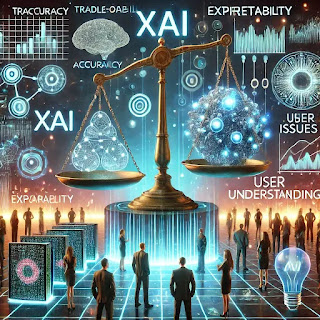Explainable AI (XAI): Making AI Transparent and Trustworthy.
Artificial Intelligence (AI) has
become an integral part of modern life, influencing everything from healthcare
and finance to social media and autonomous vehicles. However, as AI systems
become more sophisticated, they also become more opaque, often operating as
"black boxes" that provide decisions without clear explanations. This
lack of transparency raises concerns about bias, accountability, and trust,
leading to the growing importance of Explainable AI (XAI).
Explainable AI (XAI) refers to a
set of methods and techniques that make AI models more interpretable and
understandable to humans. It aims to bridge the gap between complex AI
decision-making processes and the need for transparency, ensuring users—whether
they are developers, businesses, or end-users—can comprehend and trust AI
systems.
Why Does XAI Matter?
1. Trust and
Transparency:
When AI systems are used in
critical areas like healthcare, finance, and criminal justice, their decisions
must be understandable to avoid potential risks. For example, if an AI-powered
medical diagnostic system recommends a specific treatment, doctors must
understand the reasoning behind it to make informed decisions.
2. Accountability and
Fairness:
AI models can sometimes exhibit
biases due to flawed training data. If an AI system used in hiring
disproportionately rejects candidates from certain backgrounds without
explanation, it could lead to discrimination. XAI helps identify and mitigate
such biases, promoting fairness and accountability.
3. Regulatory
Compliance:
Governments and regulatory bodies
are increasingly demanding transparency in AI-driven decision-making.
Regulations like the European Union's General Data Protection Regulation (GDPR)
require AI systems to provide explanations for automated decisions that affect
individuals.
4. Improved AI
Performance:
Understanding how an AI model
makes decisions allows developers to refine it, address weaknesses, and improve
its accuracy. A transparent AI system is also easier to debug and optimize.
Approaches to Explainable AI
There are several approaches to
making AI more explainable, categorized into intrinsic and post-hoc methods:
1. Intrinsic Explainability:
Some AI models are inherently
interpretable because they use simpler architectures. Examples include:
·
Decision
Trees – These models break down decisions into a sequence of logical steps
that are easy to follow.
·
Linear
Regression – A straightforward model that shows the relationship between variables
through coefficients.
·
Rule-Based
Systems – AI models that make decisions based on predefined rules, ensuring
transparency.
2. Post-Hoc
Explainability:
More complex AI models, such as
deep learning neural networks, require additional techniques to interpret their
outputs. Some common post-hoc methods include:
· LIME (Local Interpretable Model-Agnostic Explanations) – Creates simpler models to approximate and explain specific AI predictions.
·
SHAP
(Shapley Additive Explanations) – A game-theoretic approach that assigns
importance values to features influencing AI decisions.
·
Feature
Visualization – Helps visualize how neural networks interpret inputs, often
used in image recognition models.
·
Counterfactual
Explanations – Provides "what-if" scenarios to help users
understand how different inputs affect an AI’s decision.
Real-World Applications of XAI
·
Healthcare:
AI is
increasingly used in medical diagnostics, drug discovery, and treatment planning.
Explainable AI helps doctors understand why an AI system suggests a specific
diagnosis or treatment, improving patient trust and outcomes.
·
Finance:
Banks and financial institutions use AI for credit scoring, fraud detection, and investment strategies. XAI ensures that these models are transparent, helping customers and regulators understand why a loan application was approved or denied.
·
Autonomous
Vehicles:
Self-driving
cars rely on AI for navigation, object detection, and decision-making. XAI
helps engineers debug models and ensure the safety of these systems by making
their decisions more interpretable.
·
Legal and
Criminal Justice:
AI is used to
assess risks in parole decisions and predictive policing. Without
explainability, biased AI models could lead to unjust outcomes. XAI helps legal
professionals verify AI-driven recommendations.
Challenges in Implementing XAI
Despite its benefits, achieving full explainability in AI is challenging due to:
·
Trade-Offs
Between Accuracy and Interpretability – More complex models tend to be more
accurate but harder to interpret, while simpler models are easier to understand
but may sacrifice predictive power.
·
Scalability
Issues – Implementing XAI for large-scale, real-time AI applications can be
computationally expensive.
·
User
Understanding – Not all users have the technical expertise to interpret AI
explanations, requiring user-friendly XAI solutions.
The Future of Explainable AI
The future of AI is moving towards
increased transparency, with ongoing research and innovations aimed at making
AI models more interpretable without compromising their performance. Some
promising directions include:
· Hybrid Models – Combining interpretable and complex models to balance accuracy and explainability.
·
Standardization
and Guidelines – Governments and organizations are working on frameworks to
regulate AI transparency.
·
Human-Centered
AI – Designing AI systems with explanations tailored to different users'
levels of expertise.
Conclusion
Explainable AI (XAI) is essential for building trust, ensuring fairness, and promoting ethical AI adoption across industries. As AI continues to influence our lives, making it more transparent and understandable will be crucial in maximizing its benefits while mitigating risks. Whether you are a developer, policymaker, or everyday user, understanding and advocating for XAI can help shape a future where AI serves humanity responsibly and effectively.






